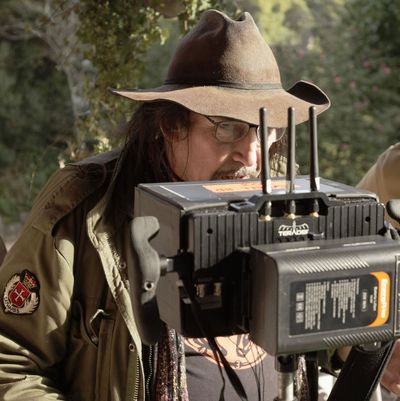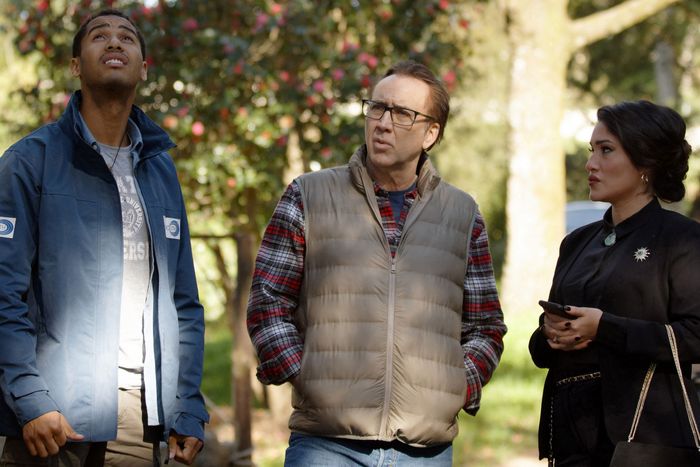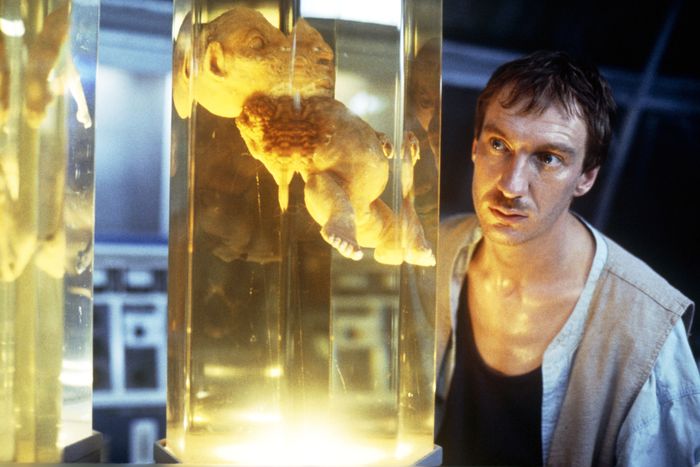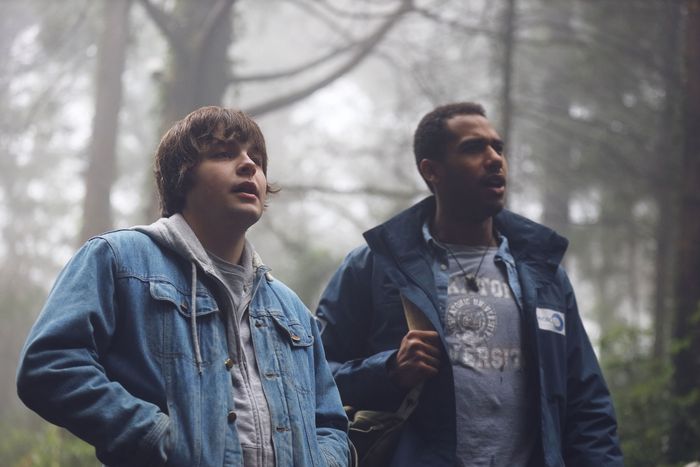
Richard Stanley’s career in Hollywood was supposed to be over. It was 1996, and he’d just been fired as the director of The Island of Dr. Moreau, a multimillion-dollar adaptation of a novel by H.G. Wells starring an aging and monomaniacal Marlon Brando. When Stanley had first conceived of the project a few years earlier, he’d been a rising star in Hollywood, fresh off the set of a relatively well-received pagan-horror art-house feature called Dust Devil. But since then, everything he’d worked so hard to build had fallen apart in spectacular fashion. The chaotic sequence of events, captured in the 2014 documentary Lost Soul: The Doomed Journey of Richard Stanley’s Island of Dr. Moreau, would go on to become known as one of the greatest filmmaking disasters of all time. Brando repeatedly disappeared from set; Val Kilmer, playing Dr. Moreau’s assistant, was also a nightmare. Meanwhile, Stanley encountered a litany of personal problems — his assistant was bitten by a venomous spider; his mother’s house was struck by lightning three times. Before shooting began, he’d hired a British warlock named Skip to magically bind himself and Brando to the project, and now Skip was hospitalized with bone disease. Almost as soon as they began filming at Cape Tribulation, a remote region of Australia, a hurricane flooded the set, destroying equipment and throwing off the schedule even further. Three days into shooting, New Line Cinema, the production company behind the film, decided to fire Stanley. And it was at this point that things got truly weird.
New Line, apparently concerned that Stanley might sabotage the shoot, asked a production assistant to escort the director onto a plane back to America. But when the plane arrived, Stanley wasn’t on it. He’d disappeared into the jungle. A month or so later, some extras found him camping out by a river, living off yams and coconuts and a substantial supply of marijuana. Eventually, he sneaked back onto set, disguised as one of Dr. Moreau’s human-dog hybrids, and joined the rest of the extras as they burned down the set in the film’s climactic finale. The movie, when it was finally released, was a commercial and critical failure.
Stanley, meanwhile, faded into obscurity until his first full feature film in 25 years was released last week. A psychedelic adaptation of an H.P. Lovecraft story, Color Out of Space is a bizarre, grotesque, yet strangely compelling tale about a family living on a remote New England farm that’s hit by a meteorite. Soon after, the family finds itself battling an extraterrestrial entity that infects each member one by one. The film, which stars Nicolas Cage in full gonzo mode, shares some of the same raw, frenetic energy as 2018’s Mandy. When Stanley began work on the script, back in 2011, he didn’t think it would ever actually be made — so many projects had not worked out since 1996. That all changed one night in 2018, when he got a call around four in the morning from “some guy in a bar in Nevada who claimed to be Nic Cage and who was saying he wants to make my movie.”
Here’s the story of Stanley’s return to a movie set, in his own words.
The Ouija Board
Stanley grew up in South Africa, where he first encountered magical practices through his mother, an anthropologist, who would take him on research expeditions to meet witch doctors. Throughout his career, witchcraft and ritual have been woven into his filmmaking process. When I asked him how Color Out of Space came to be his first film in 25 years, he recalled a session with a Ouija board from Toys “R” Us.
I’ve been a lifelong Lovecraft fan, so the broad idea has been festering in my consciousness ever since I was a kid. Really, though, it started to gather impetus a few years ago.
I thought I had safely escaped the film industry and was living on a mountain in the south of France. My co-writer on Color and I were playing around with a glow-in-the-dark Ouija board we bought from a Toys “R” Us, and the Ouija board suggested we make a short film based on the work of Clark Ashton Smith, which was a film called Mother of Toads that became the first sequence on a movie called The Theatre Bizarre that came out a bunch of years ago. The original backers of Theatre Bizarre liked the segment so much that they flew out to the south of France and offered to put up the money for us to write a feature-length Lovecraft adaptation. Color Out of Space came to the fore because it’s kind of the low-hanging fruit of the Lovecraft canon that’s set on one farm and involves one family and feels in range for medium- to low-budget filmmakers.
That must have been somewhere around 2011. The original folks who had commissioned the screenplay — I think they were bankrupt by the time we’d finished writing it.
The Phone Call From Some Guy in Nevada
Writing the script was one thing, selling the characteristically weird Richard Stanley story was another. By this time, David Gregory’s sympathetic documentary Lost Soul had attempted to set the record “straight-ish” about the various problems plaguing The Island of Dr. Moreau, many of which were out of Stanley’s control. The director says the doc helped rehabilitate his reputation with the powers that be. Still, Color might never have happened had some guy in Nevada not taken an interest.
[The script] floated around and was a little unloved for a few years until Josh Waller, the producer of Mandy, learned on the set of Mandy that Nic Cage was a huge Lovecraft fan. Then he remembered that some deeply weird screenplay had been floating around and managed to put it in Nic’s hands. The first I heard about it is that I got a phone call at about four in the morning from some guy in a bar in Nevada who was claiming to be Nic Cage and saying he wants to make my movie.
I remember I was skeptical. It was difficult for me to put two and two together at the time. I didn’t really believe the movie was getting made for a superlong time. During the 20-something very odd years since I’ve been away from the industry, so many deeply bizarre projects have come and gone without actually making the transition to screen. I remained a little unconvinced until finally, just before Christmas in 2018, Josh Waller and one of the Portuguese producers drove up from Portugal and knocked on my front door here in the Pyrenees and told me to get in the car. At that point, I started to realize that we were actually making the movie.
Nic pretty much single-handedly restored my faith in Hollywood. He brought incredible energy to [the set], and was always willing to take direction. Just his sheer presence kind of meant that the entire crew and other cast members were so on form and on point that generally we got all of his scenes in maybe two to three takes. Most of the material we were scheduled to shoot with Nic cracked along at around double the speed that I was expecting, which stands in stark contrast to the problems we had in Dr. Moreau, where in the course of the movie I believe they lost something like 44 main-unit shooting days on account of cast members simply not turning up or coming out of their Winnebagos.
An Argument With Lovecraft
What, exactly, is Color about? Lovecraft, the author of weird fiction stories about humanity’s nightmarish position in the cosmos, is famously difficult to adapt. Hence the amount of time it took for Stanley to write the script for his latest film, based on the author’s short story about a meteorite crash site that drives mad those who come into contact with it. On set, the actors helped bring Stanley’s specific version of the horror to life.
While I’m a huge Lovecraft fan, I also find that I generally don’t agree with all of his ideas. I’m not really an atheist and I’m not a materialist and I’m not a racist and I’m not a misogynist and I find his nihilism pretty hard to take. So, I saw much of the movie as being kind of an argument with Lovecraft. Maybe one of the best ways of interrogating those themes was to imagine what would happen if the [meteorite] horror was happening to one’s own family members, one’s own loved ones, to one’s parents or one’s children. I very closely based the Gardner family on my own family, and the cast members were doing much the same. (I know that Nic’s characterization was, increasingly, an evil caricature of his own father, who kind of morphs at times into Donald Trump.)
One of the principal ideas of Color was to relocate the events of the story into the present day or the near future, simply because I wanted Lovecraft’s insane universe to feel dangerous again, and not to come across as quaint — something that belonged to the 1920s and 1930s. In doing so, essentially we’ve relocated the story into a somewhat meta-textual world where Lovecraft himself possibly exists. Lavinia, the daughter of the family [played by Madeleine Arthur], has a paperback edition of the Necronomicon [a fictional textbook of magical rituals that appears in Lovecraft’s stories], which doesn’t help her. I wanted to make it clear that those rituals are no protection or any assistance whatsoever when it comes to dealing with the ultra-dimensional threat that’s facing the family.
Nic’s a big H.P. Lovecraft fan and very well-read, and he understood the appalling dramatic arcs of the various characters, which was one of the reasons that the script had stayed on the shelf. Lovecraft characters generally don’t have positive learning experiences. Usually, the only ways out of the story are death and madness. [Nic] wasn’t afraid to go there.
The Arrival of Tommy Chong
Beyond centering the story of Color on the Gardners and placing Lovecraft himself inside the movie’s universe, Stanley made another addition to the script: an entirely new, shaman-type character, who lives in the woods near the family’s farm. He initially wanted Iggy Pop to play the role, but he went with the second-best option instead: Tommy Chong.
I’ve been a fan of Tommy’s work since I was a teenager. His character — a figure who doesn’t exist in the original Lovecraft story — is closely based on a local shaman figure who was my friend here in the Pyrenees for about 30 years, a guy named Uranie. Uranie was probably the only person I know who placated Lovecraft’s old guards in all due faith. He had a French-language copy of what he believed was the Necronomicon and actually celebrated Yog-Sothoth Day and various ritual dates throughout the year. I became very fond of him over the 30 years I knew him. About two years ago, he did an invocation to Yog-Sothoth, one of the Lovecraftian deities, in order to make Out of Space happen.
We have it on videotape somewhere. A storm blows up halfway through it. It was all quite lighthearted. Unfortunately, Uranie died slightly before Color got started. He passed from 30 years of untreated hepatitis C, so he didn’t get to see the movie. So we had to find someone to stand in for him, which was tricky. I was initially thinking maybe Iggy Pop, but unfortunately Iggy was otherwise engaged with concerts at that point in time. So, I went after the next logical person: Tommy Chong.
The Rituals and Secret Shoots
The first scene in Color Out of Space is of a protection ritual performed by Lavinia — another adaptation quirk that nods to Stanley’s own relationship to magic (Lovecraft’s version of Color has no mention of witchcraft). According to Stanley, he performed a few of his own rituals to ward off danger, but that didn’t stop him from running into a few obstacles on set — particularly when, later in the movie, as the extraterrestrial threat of the meteorite grows more intense, Lavinia performs a ritual from the Necronomicon that involves a box cutter and a lot of blood.
With the cast, I kept it to just rituals to keep the shoot safe and to make certain that there was no negative blowback to anyone involved. For this reason, we ended up doing the banishing ritual at the beginning of the movie, and shied away from anything mentioned in the paperback Necronomicon.
The location really helped us because the place we were shooting in was so genuinely creepy and the weather conspired to help us — the spectral, creeping mist that always seemed to be drifting around the trees. I think everyone enjoyed the experience. It helped put them into the right frame of mind for the movie. There was a sense that we definitely felt protected. The property where we filmed was super old, and clearly various occult practices had been going on there in the 19th century. There was an overgrown chapel out in the woods. Looking into the chapel, it was clear that there was an upside-down pentagram over the altar and Templar crosses on the walls of the place.
[But] I had quite a run-in with the powers that be on Color over the scene with the box cutters where Lavinia is getting cut up, mostly because it’s violence inflicted on a young female lead. It is a little hard to bear. In point of fact, they put so much pressure on me on the set that I was unable to shoot all of the close-ups that I wanted to shoot for the actual box cutters cutting her flesh and the wounds themselves, the drops of blood dropping onto the pages of the Necronomicon. So, I secretly shot all that stuff in the bunker at Sherman Oaks. Much of that scene was shot in secret and then basically smuggled into the movie.
Weirdly, despite bullishly insisting the scene was “gratuitous” and should be dropped from the completed film, the producers abruptly changed their minds and never mentioned the matter to me again after viewing the completed sequence in context. No one ever asked me how those additional close-ups found their way into the rushes, despite having been stringently deleted from the main-unit schedule and call sheets. I guess you just have to chalk it up to the persuasive powers of black magic.
Back to the Island?
At the end of the day, Stanley believes he took the same approach to filming Color as he did Moreau — although by the time he’d begun work on the former, he’d lost touch with Skip the warlock. (“He’s been difficult to keep track of because his emails make so little sense and they’re so hard to decrypt,” Stanley said. “The last we heard from him, which was about four years ago, he was working as an adviser to the Dalai Lama.”) Now that he’s successfully mounted a new movie, is he ready to move beyond The Island? Or is he still bound to the project by Skip’s spell?
I don’t know if I’m that superstitious. It just feels like it’s one of those things that I’m supposed to deal with in this lifetime. The Island of Dr. Moreau has developed such a strong aura of its own that it seems to be forging its own destiny at this point in time. If a major reboot of the saga actually comes about as is currently being mooted, I may have no choice but to make The Island of Dr. Moreau. It’s an eerie thing. It’s one of those projects that refuses to die. No matter how far away I get from it, it keeps coming back to the doorstep.
So, another attempt may be mounted to reboot The Island, which of course is more topical than ever given that human-animal hybrids are now within the realm of contemporary science. They say that human-animal hybrids have been created in the womb, but they haven’t allowed them to be carried to full term yet, let alone delivered. But we don’t know what those superpowers are doing behind our backs. Who’s to say that the beast people don’t already exist in some form? It’s also the way that the effects are going. We’ve finally reached the era where the prospect of talking dogs and cats is now within striking distance. Cats is already out there, which is like some kind of Island of Dr. Moreau nightmare.
If I do return to the project, I guess I’ll just have to hope for better luck. I haven’t really learned an awful lot. With Color Out of Space, I took pretty much the same approach I’d taken on The Island of Dr. Moreau and previous movies. I did notice that when we were creating the Gardner farm, we were creating another sort of miniature version of the same insane scenario we had on Dr. Moreau — it was out in the middle of a forest in a very remote location, and it was a high-rainfall area, and we were bringing in a large number of alpacas. It’s just that this time everything fortunately ran according to plan and schedule.
We’re currently in the early stages of prepping for a new adaptation of “The Dunwich Horror.” That film will be set a few years after the events in Color Out of Space. I’m hoping that this time we’ll have a more generous budget to play with. We are edging, movie by movie, toward a full-scale Lovecraftian apocalypse. It has a nice sense of predestination about it. I’m simply paddling with the current and hoping that the response to Color is strong enough to be able to take this as far as I’d like it to go.





